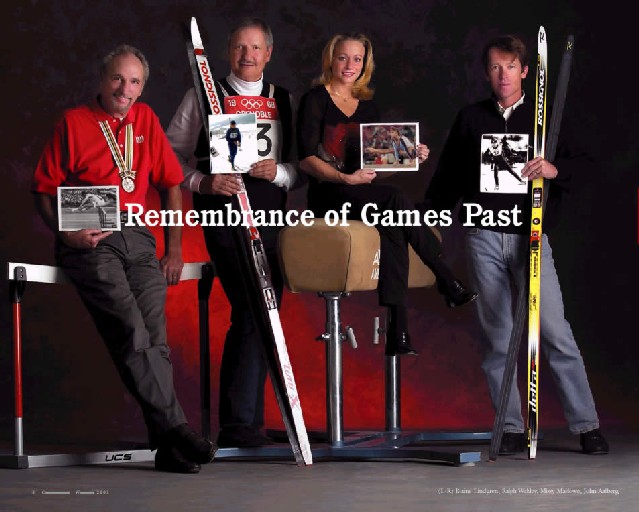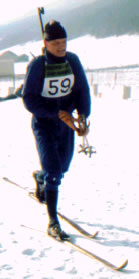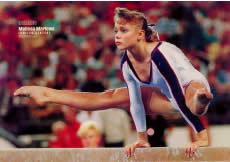
(L-R) Blaine Lindgren, Ralph
Wakley, Missy Marlow, John Aalberg
BY BOB DONOHOE
PHOTO BY SKIP SCHMIETT (click
for full image)
 One
of them remembers feeling he was at the center of the world’s political
stage. Another recalls the inspiration of gathering among the world’s
best athletes—and realizing she was one of them. Yet another ponders
the artistry of the Opening Ceremonies, and looks back now on the culmination
of a journey more enriching than the destination. The fourth, who was
really the first, remembers a too-soon lean and a camaraderie that’s
lasted a lifetime.
One
of them remembers feeling he was at the center of the world’s political
stage. Another recalls the inspiration of gathering among the world’s
best athletes—and realizing she was one of them. Yet another ponders
the artistry of the Opening Ceremonies, and looks back now on the culmination
of a journey more enriching than the destination. The fourth, who was
really the first, remembers a too-soon lean and a camaraderie that’s
lasted a lifetime.
All four of these former Utes—and former Olympians—retain a fondness for the Olympic Games that glows even as memories of their personal exploits fade. The Olympic experiences of Ralph Wakley BS’69, Missy Marlowe BS’93, John Aalberg BS’88, and Blaine Lindgren BS’62, in different eras and different cities, resonate with the spirit of the Games just as clearly today as when they ascended the world’s stage for just a moment.
| RALPH WAKLEY |
 Ralph
Wakley remembers 1968 because it was sandwiched between the Cold War and
the Vietnam War. It was also the year he participated in the biathlon
as a member of the United States Winter Olympic team.
Ralph
Wakley remembers 1968 because it was sandwiched between the Cold War and
the Vietnam War. It was also the year he participated in the biathlon
as a member of the United States Winter Olympic team.
“There was quite a stage of major world events going on,” recalls
Wakley. “Nineteen sixty-eight was the time of the Tet Offensive,
and there were intense feelings throughout the world.
“And then, the Olympics were a stage for East versus West. We were in Grenoble, France, which had the largest Communist Party in France. Charles de Gaulle, one of the heroes of World War II, was still alive then, a kind of larger-than-life character, and he opened the ceremonies. So there were quite a few things going on, especially if you were a student of the world.”
Wakley, 59, who went on to
work for now-defunct United Press International and is currently a reporter
for the Ogden Standard Examiner, was, and is, a student of the world.
The Olympic Games are “a political deal, and they always have been,”
says Wakley. “To think it’s been a competition of just the athletes
is wrong. It’s a grand geopolitical stage.”
A stage, Wakley says, that’s always had a soft underbelly. “In
1968, you signed a pledge that you hadn’t gone to a university, been
paid prize money, or spent more than a certain amount of time in a training
camp sponsored by your country. Almost everybody lied about one of those
things, so [amateurism] was a farce even then.”
Nonetheless, Wakley took away fond memories from the Winter Games. “At
the Olympics you actually got to rub shoulders with other U.S. athletes,”
he says. And he recalls proudly his fast start that had the U.S. 4 x 7.5-kilometer
biathlon relay team challenging for the lead after the first leg. “I
liked to go out first in the team relay because I’m a big guy. I
was 6-foot-4, about 175 pounds back then,” he remembers. Everybody
starts [the race] at once. You ski in your own track for about 200 meters,
and then it goes down to two tracks. So you’re fighting for position
with about 16 guys. I usually won. I finished that leg in fourth place,
just about one minute behind the Russians, who were leading. We finished
eighth, but for a moment, it was kind of exciting.”
Wakley, who also raced in the individual 20-kilometer biathlon, remains
a fan of the Olympics. “It’s a great show,” he says. “It’s
wonderful entertainment, with some incredible athletes. Where can you
get better theater than the 1980 U.S. hockey win?”
Wakley is happy the Games are coming to Utah in February. “A lot
of people don’t think about the marvelous facilities we’re going
to have here. Young kids can learn how to speed skate, ski jump, and play
hockey, and they’ll be able to dream of the Olympics. “We’ve
got one of only three luge tracks in North America, and one of the best
ski jumps,” he notes. “And these aren’t one-time facilities.
“The Olympics aren’t going to ruin Utah,” Wakley adds.
“A lot of nice people w ill come here to see the Olympics and then
go home and leave lots of their money.”
| MISSY MARLOWE |
Missy Marlowe was just 17
when she competed as a gymnast at the 1988 Summer Olympic Games in Seoul,
South Korea. 
“To be in the same place with thousands of athletes in the world
who are literally the best at what they do is so inspiring you can’t
even take it all in,” recalls Marlowe, 30, who runs the team program
at Missy Marlowe’s Gymnastics, a business she sold last summer. “On
the one hand, it was the most amazing thing I was ever a part of—the
fun, the positive energy. Even the size of it was overwhelming.”
But there was a darker side for Marlowe. “The competition was different,”
she says. “There was a lot of non-cooperation between coaches. The
competitive aspects were so stressful that it didn’t bring out the
best in people. There’s so much at stake, so much publicity, so much
money to be made. Everyone is so nervous the whole time.
“After [the meet] was over, we got to be more involved in the Olympic Games,” she recalls.
The Games ended in the fall, and she began her freshman year at the U the following January, in 1989. For Marlowe, the U was close to gymnastics heaven. “College was even better than I imagined. Better than the Olympics because we had so much publicity, so much fan support, and the best of every-thing—the best medical care, the best sports psychologists.
“In club gymnastics,
it all comes down to what your family can afford,” she says. “And
on the U.S. team, we only had those amenities when we were at a competition.
But at the U, some of the best people in gymnastics were available, and
everything was so close. I never really considered other schools.”
With the passage of more than a decade since her Olympic days, Marlowe
says her memories of the Games are more positive as well. “It’s
all glory, it’s all wonderful. People ask, ‘Would you do it
again?’ Absolutely. There was all sorts of pain, all sorts of injuries,
but it was all worth it.
“The Olympics give you the sense that you’re one of the best
athletes in the world. For me, it was being with other athletes from other
sports, as opposed to being just with gymnasts, that made it so neat.
The overwhelming image I have is of the most hopeful, hardworking people
you’ll ever want to meet. I was very inspired by it.”
| JOHN AALBERG |
Looking back on the 1992 Winter Olympic Games in Albertville, France, John Aalberg remembers the artistry of the Opening Ceremonies. More fondly, he recalls the 1994 Games in his hometown of Lillehammer, Norway. But both events, he realizes now, were simply the culmination of a journey that was perhaps more worthwhile than the goal itself.
 “You’ve
spent so much time trying to reach a goal,” says Aalberg, “and
then you’ve reached it. Being there is kind of the final phase, but
you learn so much more in the process of getting to the goal. But of course,
the Olympics is the culmination, and you always remember it.”
“You’ve
spent so much time trying to reach a goal,” says Aalberg, “and
then you’ve reached it. Being there is kind of the final phase, but
you learn so much more in the process of getting to the goal. But of course,
the Olympics is the culmination, and you always remember it.”
For the last five years, Aalberg has been involved in a different process:
working busily as an Olympic planner. Aalberg has been charged with getting
the Nordic venues up and running for Salt Lake’s Olympic Winter Games
next February.
“It’s mind-boggling.
I had no idea how much planning and expertise and money were behind an
Olympic event. Sometimes you wonder if it’s worth it,” he says.
“Then you see kids doing sports because they sometimes dream of going
to the Olympics. When you see all the kids,you say, ‘Of course it’s
really worth it.’”
At Albertville, Aalberg was the best finisher among North Americans in
the 10-kilometer cross-country race. He also skied the 50-kilometer, 30-kilometer,
and 15-kilometer individual races, and the 4 x 10-kilometer relay. “I
had some good races, and I was pretty much the only athlete who was working
full time,” he notes. “I was racing against professionals.
“It was very special because it was my first Olympics,” he adds. “What I remember more than anything was the Opening Ceremonies. It was very artistic. They had dancers who looked like they were walking on air. “Lillehammer was even more special because I grew up there,” he recalls. “I lived there for 20 years, and the winter conditions were never so perfect. The biggest crowds were for the cross-country events. I skied the [4 x 10-kilometer] relay, and the people were four or five deep along the whole 5-kilometer course. “Norway was the heavy favorite, and they lost the sprint at the end to Italy. I’d never have guessed that 100,000 people could be so quiet.”
| BLAINE LINDGREN |
 It
would be easy for Blaine Lindgren to dwell on his first-across-the-finish-line,
second-place finish at the1964 Olympic Games in Tokyo, a bizarre circumstance
in the 110-meter hurdles final that could have tarnished the Olympic experience
for Lindgren. But that would miss the point, Lindgren says.
It
would be easy for Blaine Lindgren to dwell on his first-across-the-finish-line,
second-place finish at the1964 Olympic Games in Tokyo, a bizarre circumstance
in the 110-meter hurdles final that could have tarnished the Olympic experience
for Lindgren. But that would miss the point, Lindgren says.
“Nothing I could do about it,” he says matter-of-factly. “That’s
one of the things I learned from competition: once a competition’s
over, it’s over, and you move on.”
The strange finish gave Lindgren’s American teammate, Hayes Jones,
who finished behind Lindgren, the gold medal. Lindgren got silver—although
nobody was sure who won for awhile. “They actually announced me as
the winner,” says Lindgren. “That lasted for about 45 minutes.
“In those days,” Lindgren explains, “you had to break the
tape to win. All through the preliminary heats, there was only one white
line at the finish. But in the final, to help calibrate the photo-finish
apparatus, they put five white lines, a meter apart, leading up to the
finish. I came off the last hurdle in the lead, and leaned at the first
line, five meters early. I actually went under the tape.” Thus, the
gold went to Jones.
Lindgren moves on easily to what he considers his fondest memories of
the Olympics: “the camaraderie, making friends I’ve had for
a lifetime,” he says. “It was a fantastic experience to meet
so many different people from so many cultures and countries. It gives
you a pretty good appreciation of other people.”
Lindgren’s recollections come just two days after the terrorist attack
September 11, 2001, at the World Trade Center in New York, and the Pentagon,
outside Washington, D.C. “I’m a little upset about how some
people are reacting to people of Middle Eastern descent in this country,”
says Lindgren, whose athletic experiences took him around the world about
eight times. “There’s good and bad in all cultures.”
At Tokyo, he enjoyed the capstone of that experience. “To me, the
Olympic Games are the ultimate. There’s an old saying: ‘Once
an Olympian, always an Olympian.’ I made some tremendous friendships.
Billy Mills comes and skis once a year. I still correspond with Martin
Lauer of Germany and Anatoly Mikhailov [the Soviet bronze medalist in
the 110-meter hurdles in 1964].”
Lindgren credits his U track coach, Mark Hess, with helping him get to
the Games. “He helped me develop into a good hurdler, and he took
it upon himself to get me involved in invitational meets around the country.
The good competition helps you develop.”
Hess also helped arrange limited funding for Lindgren’s trip to the
Olympic trials in New Brunswick, N.J. “The Judge Memorial Boosters
Club actually paid for the trip. But I had to stay on a chaise lounge
in another guy’s room because I couldn’t afford a hotel room.”
The memories bring Lindgren to the 2002 Olympic Winter Games. He’s
happy the Games are coming to Utah, but feels forgotten by the Salt Lake
Organizing Committee. “I haven’t even gotten a sniff from SLOC.
There aren’t a whole lot of [Utah Olympians]. You’d think there’d
be a way to get us involved.” So Lindgren plans a limited role: he
and his wife, Maiva, will help his old friend Chuck Schell with athlete
services at the E Center. “We’re looking forward to a good time.”
In the meantime, the 62-year-old Zion’s Bank employee marvels at
the constant flow of autograph requests from Germany, of all places. “Three
or four letters a month,” he says. “Apparently, there’s
quite a movement to collect Olympic autographs. They must have a good
Internet site.”
—Bob Donohoe JD’93,
a former Salt Lake Tribune sports writer, wrote about Keith Embray
BS’92 MS’98 in the Summer 2001 Continuum.
![]()
When athletes from around the world walk into Rice-Eccles Olympic Stadium
in February for the Opening Ceremonies, law student Felicia Canfield hopes
to be at the head of the pack, representing American Samoa in skeleton.
The skeleton, a sort of stripped-down bobsled ridden headfirst, makes
its return to the Games in 2002. It was last contested in 1948, and women
have never competed in the Olympics in skeleton.
 Canfield
wasn’t always so excited about the idea. Her husband, Brady, had
been competing in the sport for several years before a friend talked her
into trying it. Six runs in the spring of 2000 at Park City’s Olympic
Park whetted her appetite. Then officials from American Samoa, who were
trying to field a women’s team, approached Canfield about signing
up. She had lived in American Samoa for six years
Canfield
wasn’t always so excited about the idea. Her husband, Brady, had
been competing in the sport for several years before a friend talked her
into trying it. Six runs in the spring of 2000 at Park City’s Olympic
Park whetted her appetite. Then officials from American Samoa, who were
trying to field a women’s team, approached Canfield about signing
up. She had lived in American Samoa for six years
as a teen and graduated from high school there. “Of course, I said
no,” recalls Canfield. “I’m in law school, and I have three
kids.”
But the thrill of the sport—she describes it as “the most exciting
of all the ice sliding sports”—and the lure of the Olympic Games
eventually helped her change her mind. So did her three children. “I
consulted with the kids and explained how things would change if I decided
to compete,” she says. “They’re pretty much on board. My
oldest [12-year-old Sterling] said, ‘You’ve got to do it.’
My middle one [11-year-old Adrian], the diplomat, added, ‘Besides,
you’re not getting any younger, so you’d better do it now.’”
Canfield likely won’t know if she has qualified for the Olympics
until the end of the World Cup season in mid-January, or even until an
extra qualifying race, the Challenge Cup, is held in Altenburg, Germany,
the last weekend of January. She’s taken off the fall semester of
her third year of law school to participate in five World Cup races and
to pursue the Olympic dream she shares with her husband, a mem-ber
of the U.S. Skeleton Team.
Canfield’s Olympic dream likely wouldn’t have been possible
without the understanding of her law professors, or without the help of
her fellow students. She missed three weeks of class in the fall semester
of her second year, and four consecutive weeks last spring. “I came
back to a stack of cassette tapes [of lec-tures]. It was challenging,”
she says.
After the Olympics, Canfield will participate in the law school externship
program, clerking for Utah
Supreme Court Justice Christine Durham. She’ll graduate a semester
late, then go to work for the Salt
Lake City law firm of Fabian and Clendenin. In the meantime, externships,
law school, and her employer can all wait.
“When presented with an opportunity like the Olympics,” she
says, “I’d be an idiot not to try.”